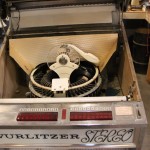1963 Wurlitzer Jukebox 2710
This 1963 Wurlitzer jukebox had its electronics serviced so that it could play all the owner’s favorite songs again.
Explore the Project Galleries
Item
The Wurlitzer family began establishing its reputation for making and selling fine musical instruments during the 17th century. The father of the original Wurlitzer company, Rudolph Wurlitzer was born in Schilbach, Saxony in 1829. At age 24 he migrated to America, and three years later, in 1856, he founded The Rudolph Wurlitzer Company in Cincinnati, Ohio.
Initially he imported musical instruments from his family in Germany to sell on the American market, but soon moved into
manufacturing. In 1880, the first Wurlitzer piano was built in the U.S., followed by the first coin-operated electric piano in 1896. This was just the beginning of what would prove to be a continuing success story, as the first Wurlitzer Jukebox was just a step away.
At the end of the war, in 1946, sales of the Wurlitzer 1015 Jukebox took off. People were mesmerized by the styling details, including animated bubble tubes, revolving color columns, and a revealed record-changing mechanism. This forerunner to today’s One More Time model sold over 56,000 units during its first 18 months on the market—going on to become the most successful jukebox of all time.
Throughout the next few decades following the jukebox’s golden years, Wurlitzer continued to steadily release innovative designs. The record selection capacity increased. The audio quality of the jukeboxes was improved, and stereo sound quickly replaced mono. During this period, musical standards also shifted from 78 RPM vinyl records to 45′s and LP’s. Wurlitzer was consistently an early adapter of these new technologies. The popularity of jukeboxes, however, began to wane slightly in these years as television took over as the dominant form of entertainment.
Read more about Wurlitzers at: http://wurlitzer.de/en/tradition/



